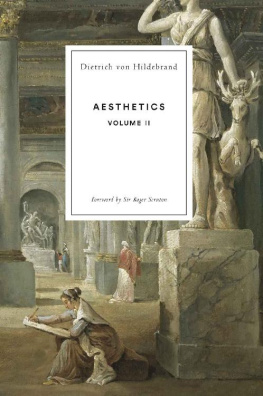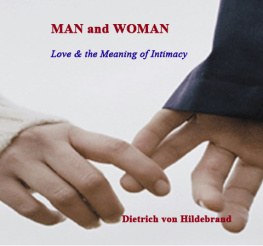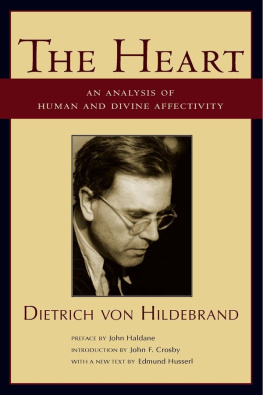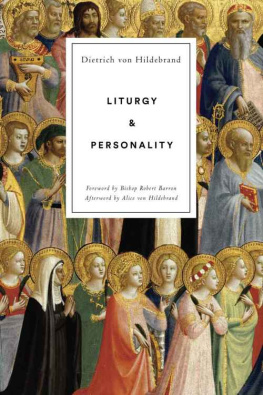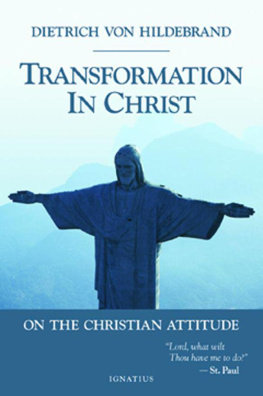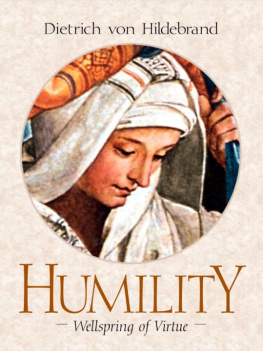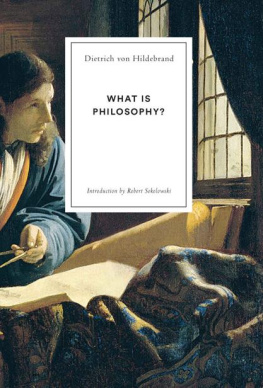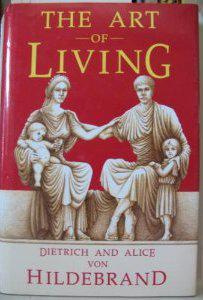Dietrich von Hildebrand - Aesthetics:Volume II
Here you can read online Dietrich von Hildebrand - Aesthetics:Volume II full text of the book (entire story) in english for free. Download pdf and epub, get meaning, cover and reviews about this ebook. year: 2019, publisher: Hildebrand Press, genre: Science. Description of the work, (preface) as well as reviews are available. Best literature library LitArk.com created for fans of good reading and offers a wide selection of genres:
Romance novel
Science fiction
Adventure
Detective
Science
History
Home and family
Prose
Art
Politics
Computer
Non-fiction
Religion
Business
Children
Humor
Choose a favorite category and find really read worthwhile books. Enjoy immersion in the world of imagination, feel the emotions of the characters or learn something new for yourself, make an fascinating discovery.
- Book:Aesthetics:Volume II
- Author:
- Publisher:Hildebrand Press
- Genre:
- Year:2019
- Rating:4 / 5
- Favourites:Add to favourites
- Your mark:
- 80
- 1
- 2
- 3
- 4
- 5
Aesthetics:Volume II: summary, description and annotation
We offer to read an annotation, description, summary or preface (depends on what the author of the book "Aesthetics:Volume II" wrote himself). If you haven't found the necessary information about the book — write in the comments, we will try to find it.
Dietrich von Hildebrand: author's other books
Who wrote Aesthetics:Volume II? Find out the surname, the name of the author of the book and a list of all author's works by series.
Aesthetics:Volume II — read online for free the complete book (whole text) full work
Below is the text of the book, divided by pages. System saving the place of the last page read, allows you to conveniently read the book "Aesthetics:Volume II" online for free, without having to search again every time where you left off. Put a bookmark, and you can go to the page where you finished reading at any time.
Font size:
Interval:
Bookmark:
Thinkers and Artists on the Hildebrandian Vision of Beauty
How does the beautiful evangelize? Following Dietrich von Hildebrand, we should say that the truly beautiful is an objective value, to be distinguished from what is merely subjectively satisfying. This means that the beautiful does not merely entertain; rather, it invades, chooses, and changes the one to whom it deigns to appear. It is not absorbed into subjectivity; it rearranges and redirects subjectivity, sending it on a trajectory toward the open sea of the beautiful itself.
BISHOP ROBERT BARRON
Theologian, author, and founder of Word on Fire Ministries
Dietrich von Hildebrand was among the first to recognize the magnitude of the intellectual crisis. He understood the centrality of beauty not merely to art but to philosophy, theology, and ethics. In his ambitious and comprehensive Aesthetics, now translated into English for the first time, von Hildebrand rehabilitates the concept of beauty as an objective rather than purely subjective phenomenon. His systematic account renews the Classical and Christian vision of beauty as a reliable mode of perception that leads humanity toward the true, the good, and ultimately the divine.
DANA GIOIA
Poet and former chairman of the National Endowment for the Arts
In Aesthetics II, Dietrich von Hildebrand offers a thorough reflection on the distinctive characteristics of architecture, sculpture, painting, literature, and music. He guides the mind with clarity even if the reader is not used to systematic intellectual reflection on a topic often relegated to the realm of subjective taste. The objective splendor that lies within a work of art, somehow transcending its human author, is one of many points worth contemplating in this volume. I am convinced that the section on music echoes not just my own experience but that of many performers striving to do justice to the works they bring to life. Whoever is looking for an aesthetic vision of the whole will find Aesthetics II deeply insightful, challenging, and encouraging.
MANFRED HONECK
Grammy-winning conductor
Music Director of the Pittsburgh Symphony Orchestra
I remember so well when, as a young priest in the early 1950s, I was invited to a house owned by the von Hildebrand family, which lay within the boundaries of the parish where I was assigned, to attend one of the conferences he was accustomed to give during his summer visits to Europe. Not surprisingly his theme was beauty, and with great eloquence and enthusiasm he spoke of its philosophical and spiritual importance. The joy and freshness of his understanding of Catholic doctrine were contagious and stood in marked contrast to the dryness of a kind of scholasticism that seemed then to have become stale and brittle. Listening to him, one recognized that it was the transcendent beauty of truth that had captured his heart and his mind.
JOSEPH CARDINAL RATZINGER
Most philosophers of aesthetics content themselves with a few examples from the realm of art, and make no attempt to explore the distinct disciplines or to catalogue all the parts that contribute to the overall aesthetic effect. One purpose of this second volume, however, is to show the completeness of the artistic enterprise, and the way in which it penetrates human life in its entirety, so that the idea of beauty enters our practical activity at every point. We are seeking harmony and order in everything we do, and even if the sublime effects of the most spiritual works of art are beyond our everyday competence, we will always be motivated in our everyday activities by a fundamental need for harmony and an aversion to ugliness.
SIR ROGER SCRUTON
Philosopher and author
Dietrich von Hildebrands engaging studies of different art forms is a marvelous illustration of the way phenomenology is uniquely accessible to a wider readership. Here is philosophy for the sake of the world. The result is a voracious, encyclopedic explorationone is almost tempted to say a rompthrough a range of concrete examples that would deepen anyones appreciation for what the arts can do. Most importantly, in an age of flattening reductionism, this book paints a picture of what it might mean for humanity to find its fullness through cultivating the same range of aesthetic curiosity.
JAMES K. A. SMITH
Professor of philosophy, Calvin College Editor in chief, Image journal
Aesthetics

Dietrich von Hildebrand

Originally published in German as Asthetik. 2. Teil. ber das Wesen des Kunstwerkes und der Knste. Gesammelte Werke Band VI. Regensburg: Habbel; and Stuttgart: Kohlhammer. 1984.
English translation published 2018 by Hildebrand Project, 1235 University Blvd, Steubenville, Ohio 43952
Copyright 2018 Dietrich von Hildebrand Legacy Project
All rights reserved
Cataloguing-in-Publication Information
Von Hildebrand, Dietrich, 18891977 | Scruton, Roger, foreword author | McNeil, Brian, translator | Crosby, John F., 1944, translator and editor | Crosby, John Henry, translator and editor.
[sthetik. English]
Aesthetics : volume II / by Dietrich von Hildebrand ; foreword by Sir Roger Scruton ; translated by Fr. Brian McNeil, John F. Crosby and John Henry Crosby; edited by John F. Crosby and John Henry Crosby.
Includes bibliographical references and index. | Steubenville, OH: Hildebrand Press, 2018.
LCCN 2018909970
ISBN 978-1-939773-10-4
Subjects: LCSH: Aesthetics. | ArtPhilosophy. | Phenomenology and art. | BISAC: PHILOSOPHY / Aesthetics | PHILOSOPHY / Movements / Phenomenology | ART / General
Classification: LCC B3359 .V6 2018| DDC 701dc23
Book design by Mark McGarry, Texas Type & Book Works
Set in Adobe Caslon
Cover Design by Marylouise McGraw
Cover Image: Hall of the Seasons, by Robert Hubert, in the Muse du Louvre, Paris.
Image from Wikimedia Commons.
Front Cover Font: Circular Bold by Laurenz Brunner
www.hildebrandproject.org
SUAVISSIMAE DILECTISSIMAE UXORI
To my most sweet and beloved wife

Contents
by Sir Roger Scruton

Dietrich von Hildebrand
Dietrich von Hildebrand was born in Florence in 1889, and studied philosophy under Adolf Reinach, Max Scheler, and Edmund Husserl. He was received into the Catholic Church in 1914. He distinguished himself with many publications in moral philosophy, in social philosophy, in the philosophy of the interpersonal, and in aesthetics. He taught in Munich, Vienna, and New York. In the 1930s, he was one of the strongest voices in Europe against Nazism. He died in New Rochelle, NY in 1977.

Hildebrand Project
We advance the rich tradition of Christian personalism, especially as developed by Dietrich von Hildebrand and Karol Wojtyla (Pope St. John Paul II), in the service of intellectual and cultural renewal.
Our publications, academic programs, and public events introduce the great personalist thinkers and witnesses of the twentieth century. Animated by a heightened sense of the mystery and dignity of the human person, they developed a personalism that sheds new light on freedom and conscience, the religious transcendence of the person, the relationship between individual and community, the love between man and woman, and the life-giving power of beauty. We connect their vision of the human person with the great traditions of Western and Christian thought, and draw from their personalism in addressing the deepest needs and aspirations of our contemporaries. For more information, please visit: www.hildebrandproject.org
Next pageFont size:
Interval:
Bookmark:
Similar books «Aesthetics:Volume II»
Look at similar books to Aesthetics:Volume II. We have selected literature similar in name and meaning in the hope of providing readers with more options to find new, interesting, not yet read works.
Discussion, reviews of the book Aesthetics:Volume II and just readers' own opinions. Leave your comments, write what you think about the work, its meaning or the main characters. Specify what exactly you liked and what you didn't like, and why you think so.

